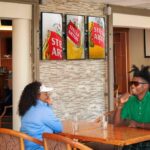 By Lukanyo Bushwana, Strategist at The MediaShop
By Lukanyo Bushwana, Strategist at The MediaShop
Covid-19 has undeniably acted as a catalyst to speed up digital adoption and introduce new trends at a rate that few could have predicted. As a result, the vast majority of marketers have refocused their digital efforts and rightfully so; you fish where the fish are.
Every impression is an opportunity. As consumers begin what is now called “revenge spending”, brands need to be more discoverable than ever before. Increased ease of movement and what people can do provide opportunities to influence consumers, where every impression is an opportunity to connect. To make use of this, marketers should use dynamic creative information, choose inventory near points of interest and understand the mobility patterns of their granular audiences.
In the past few years there has been a lot of talk about Programmatic Digital out of Home (pDOOH) and how it will revolutionize the OOH industry and change the way marketers and brands buy media space and how media owners sell OOH. Obviously, pDOOH has already been in existence in some of the biggest markets or the so called ‘first world countries’ but what’s exciting is that a few South African OOH suppliers are investing in this type of media.
So what is Programmatic Digital out of Home?
Programmatic digital out of home, refers to the automated buying, selling, and delivery of out of home advertising or ads on digital billboards and signage. With programmatic DOOH, computers automate the sale and delivery of ad content in a similar way to what you see with most online advertising. Buyers will set conditions under which they want to buy media, and when those conditions are met, ads are then purchased automatically.
Brands can achieve some real benefits when programmatic DOOH is planned and activated within an omni-channel programmatic campaign. Programmatic methods have expanded the traditional perception of OOH purely as a brand-building medium, to incorporate performance driven objectives and, in these unpredictable times, programmatic OOH could be the best advertising weapon for brands.
One of the biggest advantages of this medium is its ability to run hugely impactful ads on premium digital sites with relevance and flexibility. Creative can be adjusted at the click of a button in response to time sensitive information like sports results, breaking news or even the change in weather.
A good example of pDOOH is from an international food delivery brand called foodora. This brand used weather, time of day, and location data to drive a creative campaign effectively within a very relevant programmatic DOOH campaign. Audiences were delivered different messages at lunch and around dinnertime. They were prompted to go for a nice walk to pick up their food if it was sunny, and to treat themselves to delivery when it was raining. The restaurants suggested to them were different depending on where they were located when seeing the ad. All of this was accomplished without any additional input from foodora once the campaign had been set up. See link below to view the foodora case study.
Add to that, digital OOH is 100% fraud-free, safe and transparent due to its broadcast nature, so there’s no risk of ad-blockers, viewers skipping the ad or campaigns appearing in undesirable or unsuitable locations.
As a media strategist myself, I am very excited about this platform and can’t wait to execute brilliant creative ideas that will probably bring me my first media accolade!
- MRF Unveils Latest MAPS® Data - 20th February 2025
- The BRC announces changes to the board and updates for 2025 - 17th December 2024
- Top 50 DSTV TV programmes – October 2024 - 12th November 2024




